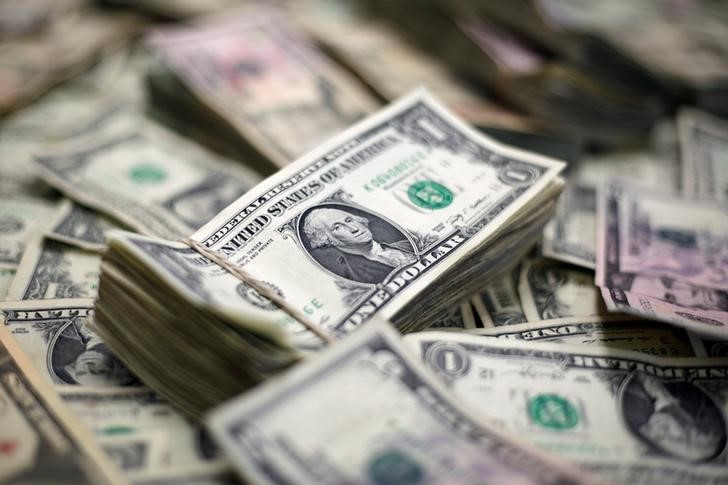 © Reuters. FILE PHOTO: U.S. Dollar banknotes are seen in this photo illustration
© Reuters. FILE PHOTO: U.S. Dollar banknotes are seen in this photo illustrationBy Dhara Ranasinghe and Saikat Chatterjee
LONDON (Reuters) – A surge in U.S. short-term bank funding costs, traditionally a key gauge of stress, has grabbed the attention of investors who are trying to assess whether it has wider ramifications for international markets.
The three-month London interbank offered rate (Libor)
Analysts say the rise largely reflects increased U.S. Treasury bill issuance and repatriation of funds, with a limited impact so far on other markets.
The spread was a leading indicator of previous dollar funding crises in 2008 and 2011-12, and some analysts believe it could again have significant knock-on effects, particularly when central banks are winding down crisis-era stimulus policies.
Here are five pressure points that investors are watching to see if the surge escalates into a global dollar funding crisis.
1/ Non-U.S. dollar funding costs
A blowout in the U.S. Libor-OIS spread hasn’t been accompanied by a widening in equivalent spreads in other currencies such as euros, Japanese yen or sterling.
Investors say this shows there is no widespread rush to secure cheap funds elsewhere.
“If this was a crisis sign in the market, then we would see other spreads blow out as well at the same time, which we saw in the last financial crisis and in the euro zone crisis,” Tim Forster, portfolio manager at Fidelity International, said.
Andrew Milligan at Aberdeen Standard Investments, said one vulnerability could be emerging markets that borrow in dollars or have currencies pegged to the dollar.
The Hong Kong dollar
(For graphic on Global Funding Costs, click http://reut.rs/2FZtNCU)
2/ Currency hedges
One of the first places where a rush for dollar funding escalates is in the arcane but deeply liquid world of currency basis swaps, used by institutional investors to hedge their foreign bond investments.
During the 2008 financial crisis and the 2011-2012 euro zone debt crisis, banks, especially non-U.S. institutions that found themselves shut out of the U.S. interbank markets, tapped the currency swaps markets in euros and yen and exchanged them.
But this time around, funding pressures are absent. If anything, these markets are indicating a surfeit of dollars with currency swaps in yen and euros at five-year highs.
This is due to increased regulations forcing global banks to keep more reserves and because banks anticipated the increased issuance of U.S. Treasury bills and secured dollars early.
(For graphic on FX swaps, click http://reut.rs/2Gd7cpz)
3/ Corporates
Instead of seeking dollars in U.S. money markets to fund their international operations, European corporates could issue more dollar-denominated debt at home.
With Libor, a reference rate for $200 trillion worth of dollar-denominated financial products, at its highest since 2008, analysts say a pick-up in dollar-denominated bond issuance by European corporates, especially banks, may follow.
This week has seen HSBC (L:), Europe’s largest bank, and Germany’s NRW Bank issue dollar-denominated debt.
A surge in outstanding U.S. Treasury bills to a record $2.3 trillion has also put upward pressure on short-dated U.S. bond yields – something analysts say is crowding out money market funding and forcing issuers of commercial paper to offer higher spreads amid generally rising rates.
This impacts the Libor fixing as commercial paper rates are taken into consideration by the panel of banks for Libor quotes.
“If the Libor/OIS spread stays as it is, we will see quite a big move higher in the and then dollar borrowing for foreign investors becomes more expensive,” Mike Riddell, a fund manager with Allianz (DE:) Global Investors, said.
(For graphic on USD bond issuance by European corporates, click http://reut.rs/2pz2h96)
4/ Central banks
One concern is that higher U.S. borrowing costs, if they persist, could tighten financial conditions and potentially reduce how aggressively the Federal Reserve raises rates.
The same could be true for the euro area as tighter U.S. financial conditions spill over into Europe, possibly delaying the European Central Bank’s timeline to exit stimulus. A firm euro has already contributed to tightening euro zone financial conditions faster than the ECB would like.
“The longer it goes on, the more pronounced the effects are going to be,” said Charlie Diebel, head of rates at Aviva (LON:) Investors. “It complicates the efforts of policymakers because in Europe we still have QE (quantitative easing), but we have some sort of tightening coming at the same time.”
Indeed, Commerzbank (DE:) says the sharp rise in dollar Libor rates could be seen as one additional rate hike since the Fed’s December meeting.
(For graphic on Monetary conditions in Europe tighten, click http://reut.rs/2pxBbPy)
5/ U.S. dollar
Citibank says the dollar-Libor/OIS spread has in recent years proved a good leading indicator for the dollar index, which measures the greenback’s performance against other major currencies (). Wider spreads tend to lead to a stronger dollar, with a three-month timelag.
“We are still forecasting dollar weakness on fundamental grounds – together with almost everyone else,” the bank said. “But if dollar liquidity tightening does lead to a stronger dollar, all of these processes have the ability in principle to run in reverse.”
(For graphic on Dollar and funding costs, click http://reut.rs/2pAHAc9)
(This version of the story has been refiled to add dropped word in headline)
Source: Investing.com


























